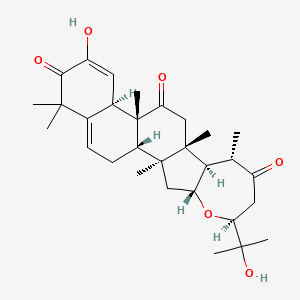| Authors | Title | Published | Journal | PubMed Link |
|---|---|---|---|---|
| Witkowski A and Konopa J | Binding of the cytotoxic and antitumor triterpenes, cucurbitacins, to glucocorticoid receptors of HeLa cells. | 1981 | Biochim. Biophys. Acta | pmid:6894552 |
| Witkowski A et al. | Inhibition of the biosynthesis of deoxyribonucleic acid, ribonucleic acid and protein in HeLa S3 cells by cucurbitacins, glucocorticoid-like cytotoxic triterpenes. | 1984 | Biochem. Pharmacol. | pmid:6546879 |
| Tannin-Spitz T et al. | Cucurbitacin glucosides: antioxidant and free-radical scavenging activities. | 2007 | Biochem. Biophys. Res. Commun. | pmid:17942079 |
| Henrich CJ et al. | Effects of cucurbitacins on cell morphology are associated with sensitization of renal carcinoma cells to TRAIL-induced apoptosis. | 2012 | Apoptosis | pmid:21928090 |
| Chen X et al. | Biological activities and potential molecular targets of cucurbitacins: a focus on cancer. | 2012 | Anticancer Drugs | pmid:22561419 |
| Yang PQ et al. | Cucurbitacin contents in Hemsleya dolichocarpa. | 1991 | Am. J. Chin. Med. | pmid:1897490 |
| Theis N et al. | Attracting mutualists and antagonists: plant trait variation explains the distribution of specialist floral herbivores and pollinators on crops and wild gourds. | 2014 | Am. J. Bot. | pmid:25156980 |
| Wang WD et al. | ANTITUMOR AND APOPTOTIC EFFECTS OF CUCURBITACIN A IN A-549 LUNG CARCINOMA CELLS IS MEDIATED VIA G2/M CELL CYCLE ARREST AND M-TOR/PI3K/AKT SIGNALLING PATHWAY. | 2017 | Afr J Tradit Complement Altern Med | pmid:28573224 |
| Guo J et al. | The anti-melanoma efficiency of the intratumoral injection of cucurbitacin-loaded sustained release carriers: in situ-forming implants. | 2015 | AAPS PharmSciTech | pmid:25609378 |
| pmid: |
Cucurbitacin S
Cucurbitacin s is a lipid of Sterol Lipids (ST) class. The involved functions are known as establishment and maintenance of localization and nitric oxide biosynthetic process.
Cross Reference
Introduction
To understand associated biological information of Cucurbitacin S, we collected biological information of abnormalities, associated pathways, cellular/molecular locations, biological functions, related genes/proteins, lipids and common seen animal/experimental models with organized paragraphs from literatures.
What diseases are associated with Cucurbitacin S?
There are no associated biomedical information in the current reference collection.
No disease MeSH terms mapped to the current reference collection.
PubChem Associated disorders and diseases
What pathways are associated with Cucurbitacin S
There are no associated biomedical information in the current reference collection.
PubChem Biomolecular Interactions and Pathways
Link to PubChem Biomolecular Interactions and PathwaysWhat cellular locations are associated with Cucurbitacin S?
There are no associated biomedical information in the current reference collection.
What functions are associated with Cucurbitacin S?
Related references are published most in these journals:
| Function | Cross reference | Weighted score | Related literatures |
|---|
What lipids are associated with Cucurbitacin S?
There are no associated biomedical information in the current reference collection.
What genes are associated with Cucurbitacin S?
There are no associated biomedical information in the current reference collection.
What common seen animal models are associated with Cucurbitacin S?
There are no associated biomedical information in the current reference collection.
